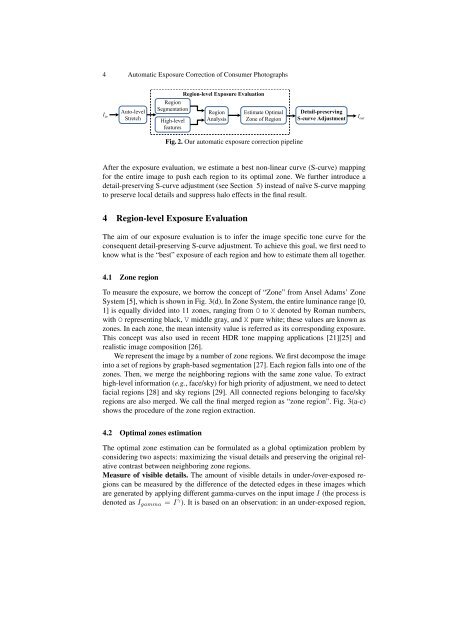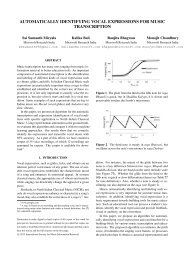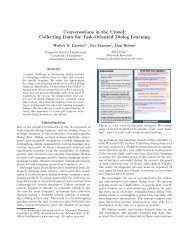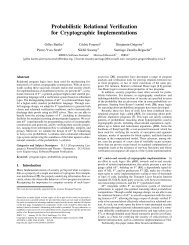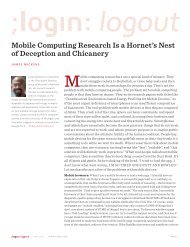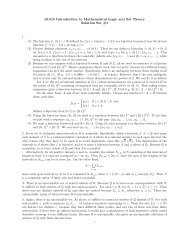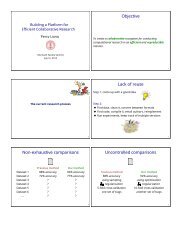Automatic Exposure Correction of Consumer Photographs
Automatic Exposure Correction of Consumer Photographs
Automatic Exposure Correction of Consumer Photographs
Create successful ePaper yourself
Turn your PDF publications into a flip-book with our unique Google optimized e-Paper software.
4 <strong>Automatic</strong> <strong>Exposure</strong> <strong>Correction</strong> <strong>of</strong> <strong>Consumer</strong> <strong>Photographs</strong><br />
I in<br />
Auto-level<br />
Stretch<br />
Region<br />
Segmentation<br />
High-level<br />
features<br />
Region-level <strong>Exposure</strong> Evaluation<br />
Region<br />
Analysis<br />
Estimate Optimal<br />
Zone <strong>of</strong> Region<br />
Fig. 2. Our automatic exposure correction pipeline<br />
Detail-preserving<br />
S-curve Adjustment<br />
After the exposure evaluation, we estimate a best non-linear curve (S-curve) mapping<br />
for the entire image to push each region to its optimal zone. We further introduce a<br />
detail-preserving S-curve adjustment (see Section 5) instead <strong>of</strong> naïve S-curve mapping<br />
to preserve local details and suppress halo effects in the final result.<br />
4 Region-level <strong>Exposure</strong> Evaluation<br />
The aim <strong>of</strong> our exposure evaluation is to infer the image specific tone curve for the<br />
consequent detail-preserving S-curve adjustment. To achieve this goal, we first need to<br />
know what is the “best” exposure <strong>of</strong> each region and how to estimate them all together.<br />
4.1 Zone region<br />
To measure the exposure, we borrow the concept <strong>of</strong> “Zone” from Ansel Adams’ Zone<br />
System [5], which is shown in Fig. 3(d). In Zone System, the entire luminance range [0,<br />
1] is equally divided into 11 zones, ranging from O to X denoted by Roman numbers,<br />
with O representing black, V middle gray, and X pure white; these values are known as<br />
zones. In each zone, the mean intensity value is referred as its corresponding exposure.<br />
This concept was also used in recent HDR tone mapping applications [21][25] and<br />
realistic image composition [26].<br />
We represent the image by a number <strong>of</strong> zone regions. We first decompose the image<br />
into a set <strong>of</strong> regions by graph-based segmentation [27]. Each region falls into one <strong>of</strong> the<br />
zones. Then, we merge the neighboring regions with the same zone value. To extract<br />
high-level information (e.g., face/sky) for high priority <strong>of</strong> adjustment, we need to detect<br />
facial regions [28] and sky regions [29]. All connected regions belonging to face/sky<br />
regions are also merged. We call the final merged region as “zone region”. Fig. 3(a-c)<br />
shows the procedure <strong>of</strong> the zone region extraction.<br />
4.2 Optimal zones estimation<br />
The optimal zone estimation can be formulated as a global optimization problem by<br />
considering two aspects: maximizing the visual details and preserving the original relative<br />
contrast between neighboring zone regions.<br />
Measure <strong>of</strong> visible details. The amount <strong>of</strong> visible details in under-/over-exposed regions<br />
can be measured by the difference <strong>of</strong> the detected edges in these images which<br />
are generated by applying different gamma-curves on the input image I (the process is<br />
denoted as Igamma = I γ ). It is based on an observation: in an under-exposed region,<br />
I out


